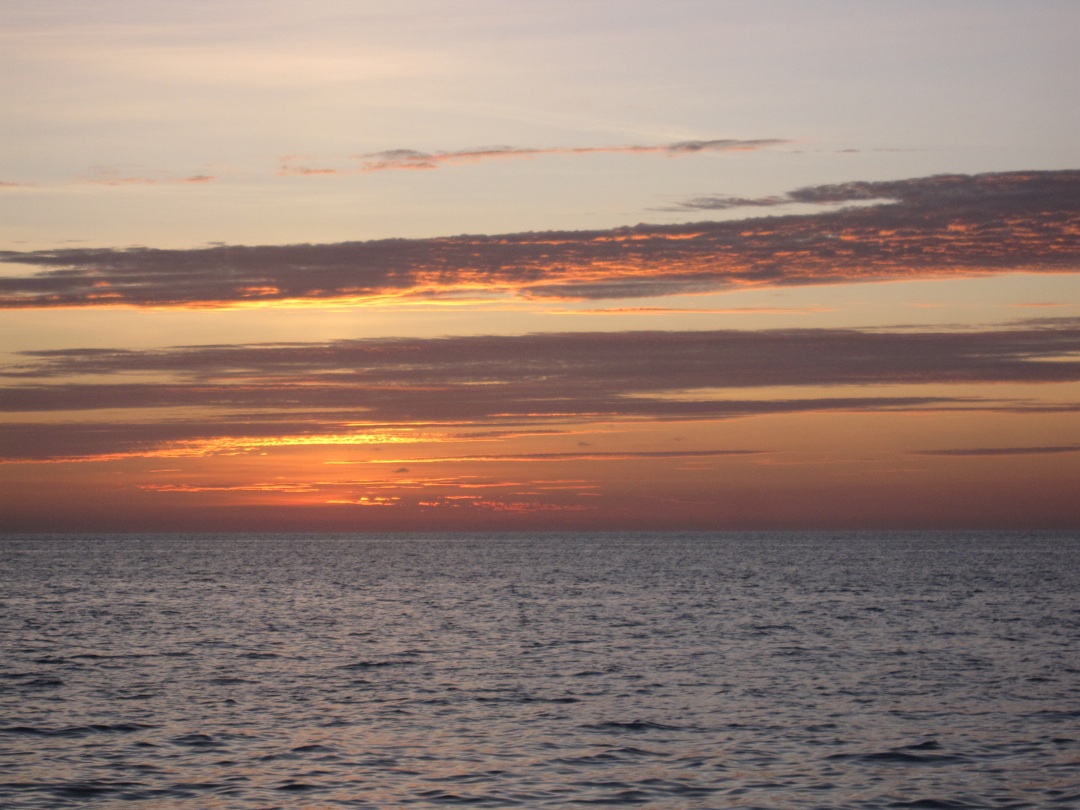MARIANI’SVirtual Gourmet
September
25, 2011
NEWSLETTER

Follow @VirtualGourmet
BERMUDA
by Christopher Mariani
NEW YORK CORNER: ZIO
by John Mariani
MAN ABOUT TOWN: FRIDAY NIGHT COOKING
by Christopher Mariani
ESOTERIC GRAPES MAKE ROUSSILLON WINES A PUZZLE
by John Mariani
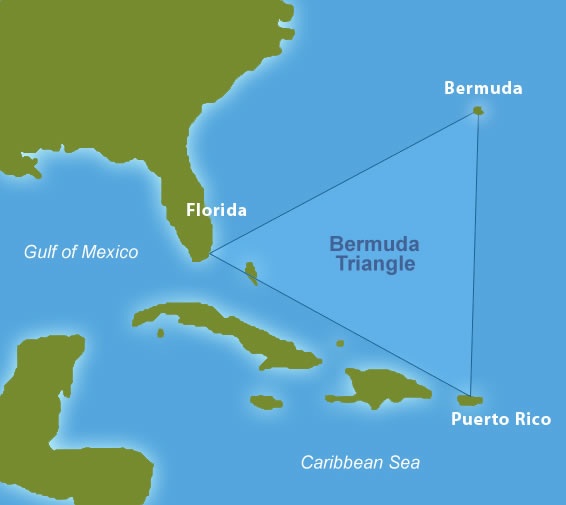 This summer I had the chance
to visit Bermuda for the first time in my life, and
wow, was I thoroughly impressed. Before I get into the
details of my stay, let me explain exactly where
Bermuda is on the map. And don’t take offense this
explanation, according to the Bermuda Tourism Board,
most Americans have not a clue where Bermuda is. Many
even believe it is part of the Caribbean.
This summer I had the chance
to visit Bermuda for the first time in my life, and
wow, was I thoroughly impressed. Before I get into the
details of my stay, let me explain exactly where
Bermuda is on the map. And don’t take offense this
explanation, according to the Bermuda Tourism Board,
most Americans have not a clue where Bermuda is. Many
even believe it is part of the Caribbean.
Bermuda lies just about 700 miles
east of the Carolinas in the North Atlantic Ocean. The
climate, although tropical, can become chilly in the
winter months because of its high latitude. Bermuda is
slightly under two hours from NYC by way of plane.
Airfare is reasonable and, even during peak season,
should cost you less than that to the islands of the
Caribbean. A large majority of tourism comes from New
York, along with massive cruise ships that spill
thousands of visitors onto the island. There is also a
huge influx of English tourists who make there way to
Bermuda via British Airways on direct flights from
London.
Upon arrival, I exited the airport,
located on the St. George side of the island and
headed straight for the Beau Rivage restaurant inside
the Newstead Belmont Hills Resort for a light lunch
and my first taste of Bermuda’s legendary fish
chowder.
There is not a restaurant in all of
Bermuda that does not serve this traditional chowder,
yet each prepares it slightly differently. There is a
definite competition among local restaurants for the
best fish chowder in town. My favorite was served to
me at Frog and Onion Pub in the Royal Naval Dockyard.
Fish chowder can be made with different types of fish
and shellfish, but typically consists of a flaky white
fish that has been shredded and stewed within spices
and fish carcasses for hours, showing some
similarities to a thick bouillabaisse and a
resemblance to New Orleans’ famous turtle soup. When
served, the chowder is topped with a splash of sherry
and best washed down with a cold beer.
The other big rivalry in Bermuda is
over who makes the best rum swizzle. The rum swizzle
is dark rum mixed with some type of fruit punch --
some sweeter than others; some frozen -- all
deceivingly strong and meant to increase one’s desire
to dance. I couldn’t tell you how many rum swizzles I
drank while in Bermuda, but I can tell you I do prefer
Bermuda’s other staple cocktail, the dark and stormy,
made with Gosling’s dark rum and Barritts Ginger Beer.
The dark and stormy, when made correctly, might easily
be one of the most perfect drinks ever created. This
mixture often gets a bad reputation in the States
because bartenders (or should I say “mixologists”…what
a joke!) use low-grade rum and poor ginger beer (not
to mention the proportions are usually off).
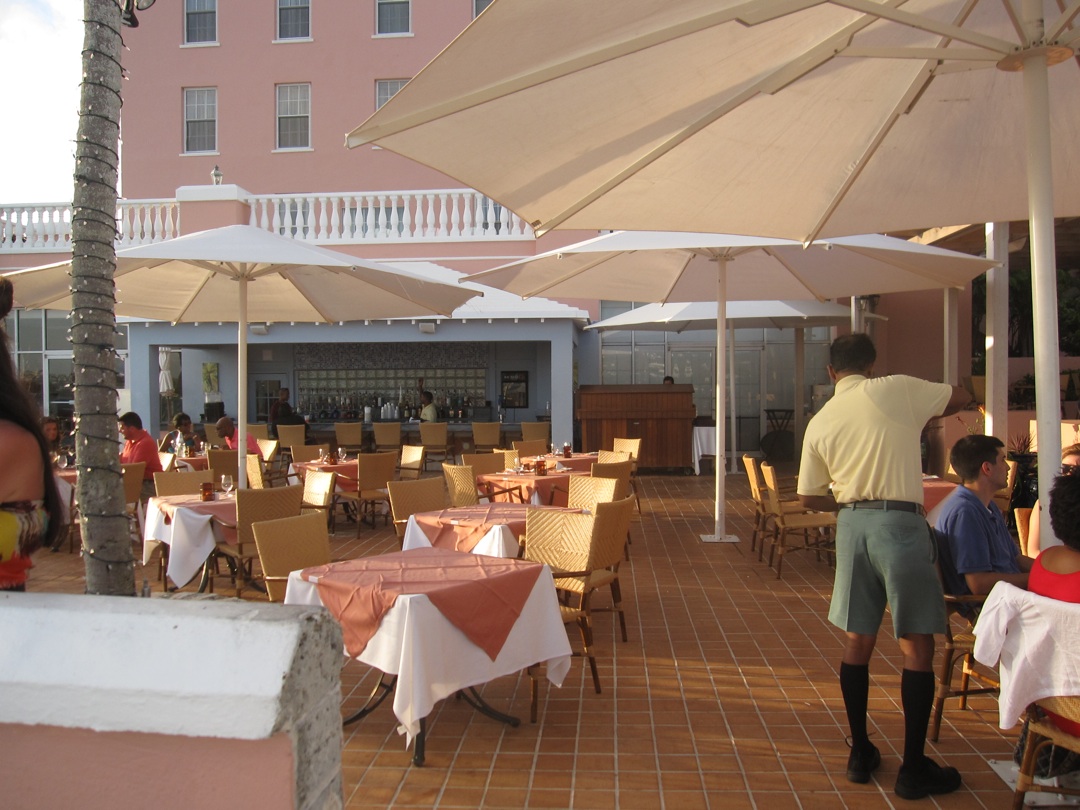 Back to the story, after lunch it was
off to the Fairmont Hamilton Princess for check-in
where I got my first glimpse of Bermuda’s ever popular
knee high socks and khaki shorts combination. The
fashion style took a bit getting used to but added a
nice island charm to the overall experience. I was
staying on the Gold Lounge floor where complimentary
snacks and breakfast are served daily as part of the
upfront cost for the room. The resort is stunning and
showcases British refinement rarely found in island
resorts. The rooms are spacious and elegantly
furnished.
That evening I dined at one of the Hamilton’s
restaurants, Harley’s, set outdoors, where I enjoyed
lots of good wine, ate great seafood and gazed out
onto the water as the sky turned from light blue to
pink and finally black with speckles of bright stars
that splattered the night sky. After dinner I walked
down the road and finished off the evening with a
cocktail or two at a well-known hangout called
Flanigans.
Back to the story, after lunch it was
off to the Fairmont Hamilton Princess for check-in
where I got my first glimpse of Bermuda’s ever popular
knee high socks and khaki shorts combination. The
fashion style took a bit getting used to but added a
nice island charm to the overall experience. I was
staying on the Gold Lounge floor where complimentary
snacks and breakfast are served daily as part of the
upfront cost for the room. The resort is stunning and
showcases British refinement rarely found in island
resorts. The rooms are spacious and elegantly
furnished.
That evening I dined at one of the Hamilton’s
restaurants, Harley’s, set outdoors, where I enjoyed
lots of good wine, ate great seafood and gazed out
onto the water as the sky turned from light blue to
pink and finally black with speckles of bright stars
that splattered the night sky. After dinner I walked
down the road and finished off the evening with a
cocktail or two at a well-known hangout called
Flanigans.
The following morning I woke up
early and jumped into a cab heading towards the Royal
Naval Dockyard where we toured the Maritime Museum,
filled with tons of old canons and naval gear perched
high above the sea cliffs pointing out towards the
sea. It was a beautiful day and although the museum
was wonderful, I needed some time in the sun. I
stopped for a quick bite at Frog and Onion Pub where I
was served the best fish chowder during my visit to
Bermuda. I
also ordered the Thursday lunch special, “Pig and
Whistle,” oven roasted baby pork ribs smothered in a
sweet and tangy barbeque sauce, sided by a tall mound
of thick cut fries. Every last morsel of swine was
washed down with a tart margarita before heading to
Bermuda’s notorious Horseshoe Bay BeachFest.
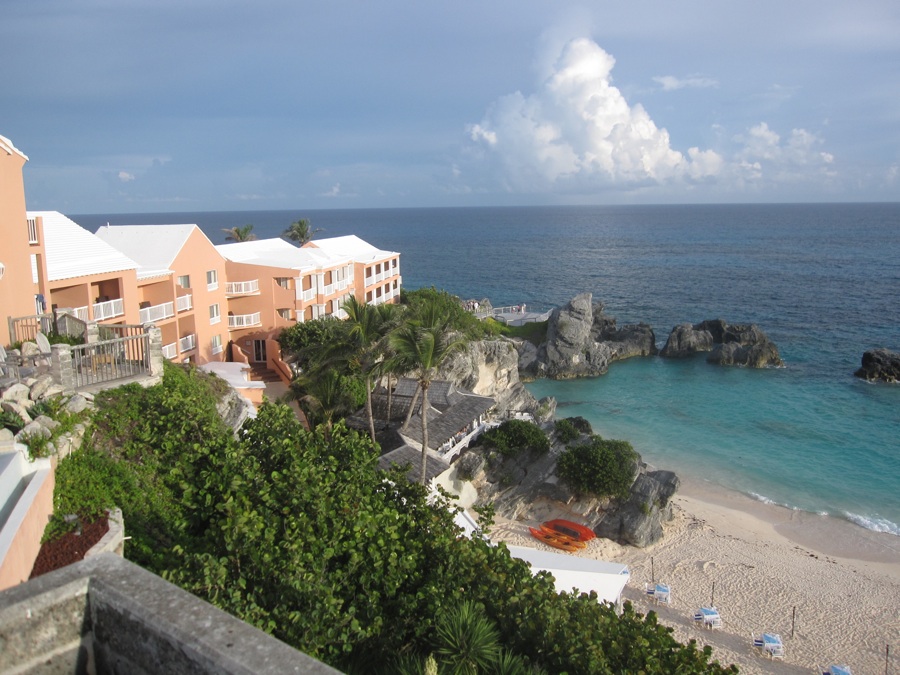 Horseshoe Bay, one of many
scenic beaches on the island, is a gorgeous strip of
beach surrounded by giant rock formations that some of
the brave locals and even courageous drunk tourists
jump off from into the shallow water below. The beach
party is full if music, food and an endless supply of
rum swizzle. Performances from local bands set the
party off as most attendees settle in with chairs and
umbrellas, only to rise for an occasional dip into the
cool water. We left in the afternoon but heard the
party lasted long into the night, maybe even the
morning.
Horseshoe Bay, one of many
scenic beaches on the island, is a gorgeous strip of
beach surrounded by giant rock formations that some of
the brave locals and even courageous drunk tourists
jump off from into the shallow water below. The beach
party is full if music, food and an endless supply of
rum swizzle. Performances from local bands set the
party off as most attendees settle in with chairs and
umbrellas, only to rise for an occasional dip into the
cool water. We left in the afternoon but heard the
party lasted long into the night, maybe even the
morning.
The following morning was Bermuda’s
annual cricket Cup Match, the real reason I was in
town. Upon showing up, the stadium was booming with
noise as music played while the crowd cheered and the
air horns blared with every point scored. Partygoers
were everywhere, representing their team by wearing
either red, blue or some combination of both colors.
Bermuda’s Cup Match showcases the biggest rivalry on
the island, St. George versus Somerset. All
businesses shut down because everyone is at the game.
The stadium was packed, the drinks flowed freely and
there was every type of seafood imaginable being sold,
as long as it has been deep-fried and topped with hot
sauce. I spent most of the afternoon walking around,
meeting people, trying new drinks and occasionally
watching the game, simply because I have no idea how
cricket is played.
George versus Somerset. All
businesses shut down because everyone is at the game.
The stadium was packed, the drinks flowed freely and
there was every type of seafood imaginable being sold,
as long as it has been deep-fried and topped with hot
sauce. I spent most of the afternoon walking around,
meeting people, trying new drinks and occasionally
watching the game, simply because I have no idea how
cricket is played.
In the far corner, there is a giant
white tent set up where Hook and Anchor is played for
the entire Holiday weekend. Hook and Anchor is the
only legal gambling allowed on the island, so trust
me, people splurge and take advantage. There is no
real thought or technique to the game; it is simply a
game of luck. After a few rolls of the dice I called
it quits and headed back towards the party tent to say
farewell to some friends. I didn’t last all afternoon
but I heard the party did not end until late into the
evening.
That night I checked into the
Fairmont Southampton and had the best meal of my
weekend at the Waterlot Inn, the only true steakhouse
on the entire island. Waterlot offers three different
USDA Prime cuts of steak along with a selection of
other top quality meats. I was surprised to see such
excellent cuts at an island restaurant. Waterlot Inn’s
food was of the quality found at some of NYC’s finest
steakhouses. I was impressed and happy to find that
the locals and tourists were educated about such
products and that they were willing to pay such high
prices for them. If you are looking for an upscale
restaurant to dine at, a huge step up from the typical
Bermudian seafood hangouts, you must try the Waterlot
Inn.
The next day I was heading back to
NY on early flight. Getting through airport security
was a breeze and my flight took off on time. Just two
hours later I was back in NY, before noon, with a
great tan and most of the day to do as I pleased.
After visiting Bermuda, I doubt I will ever take the
time to fly father south to the Caribbean again. There
really is no comparison. The Bermudians are friendly,
their island is gorgeous, their beaches are clean and,
best of all, the travel to Bermuda is quick and easy.
NEW
YORK CORNER
by John Mariani
17 West 19th Street (Between 5th and 6th Avenues)
212-352-1700
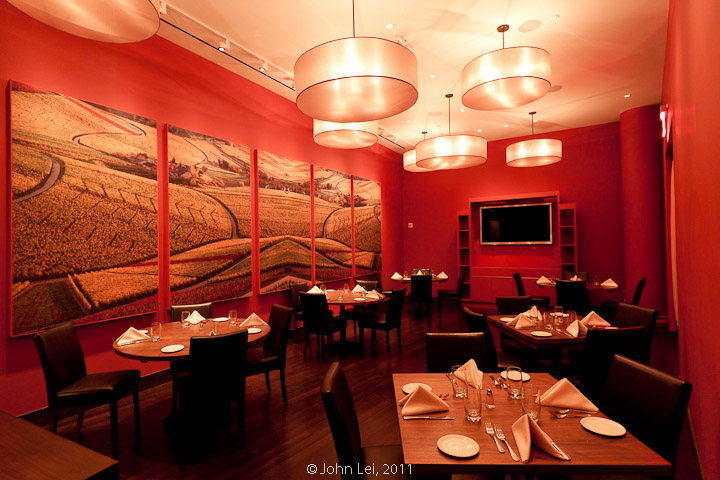 The
Flatiron District is quickly becoming a mini-Little
Italy for the number of Italian restaurants opening
around it--A Voce, Eataly, Ciano, and others--and Zio
is one of the newest, here on 19th Street since
June. Entrepreneur Darren Berman, Chef
Massimiliano Convertini, and Roberto Manfe have long
and disparate experience in running good restaurants
in Manhattan, and Chef "Max," from Ostuni in Southern
Italy, brings in flavors and dishes not found
everywhere else in town, best appreciated with his
"Tavolo di Max" tasting menus.
The
Flatiron District is quickly becoming a mini-Little
Italy for the number of Italian restaurants opening
around it--A Voce, Eataly, Ciano, and others--and Zio
is one of the newest, here on 19th Street since
June. Entrepreneur Darren Berman, Chef
Massimiliano Convertini, and Roberto Manfe have long
and disparate experience in running good restaurants
in Manhattan, and Chef "Max," from Ostuni in Southern
Italy, brings in flavors and dishes not found
everywhere else in town, best appreciated with his
"Tavolo di Max" tasting menus.
It's a big place--175 seats in all,
with 100 in the dining room and 35 in the private
party Vineyard Room, all of them obviously convivial
by the looks of guests having a very good time and
eating so well. The bay windows open onto the open
kitchen, and the whole place is done in warm tones of
brown and terra cotta, maize and off white colorings,
with soft spotlights in the ceiling and a lovely mural
of the Italian countryside. Messrs. Berman and
Manfe do their best to visit all the tables and make
sure you're having a good time, although the service
staff, especially the busboys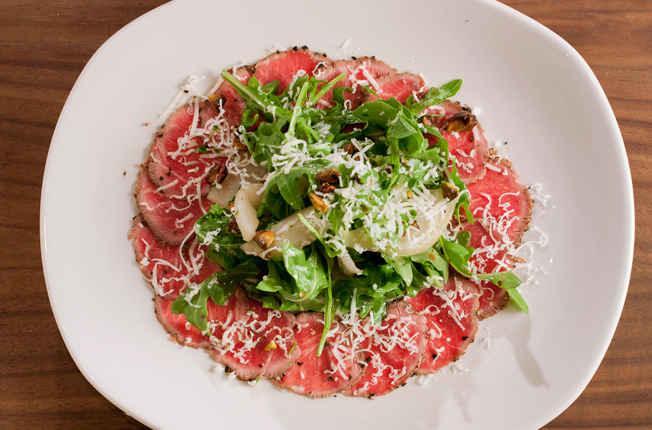 , can be
intrusive or ill informed.
, can be
intrusive or ill informed.
The pizzas here are grilled--just
three varieties, which is ideal as far as I'm
concerned, and I very much enjoyed the "al crudo" version
with prosciutto, stracchino cheese and arugula. Zio is
a place where you could easily just feast on the
unusual antipasti and be full and happy. On my
visit I tasted lightly seared lamb carpaccio (right)--quite
unusual--with poached ripe pears, arugula, truffled
pecorino, and the soft crunch of pistachios. Riso al salto--a
dish you almost never find on NYC Italian tables--was
terrific, a crsip rice pancake scented with saffron,
lavished with rich bone marrow and a gremolata sauce,
a dish I will always order here in the future. Just as
delicious was a baked eggplant torta with smoked
mozzarella, lusciously compact and intense in all its
flavors.
There are nine pastas on the menu,
ranging from very good pappardelle, also with saffron, in
a well-braised lamb ragù;
the fat tubes called paccheri with baby shrimp, roasted
eggplant and fresh mint puree, a dish that shows off
Che Max's Southern background. Lobster ravioli (below), so often
elsewhere a mushy mess, here had the real character
and texture of lobster in a tender pasta wrapping,
luxuriating in butter and lemon zest sauce--a lovely,
sumptuous dish.
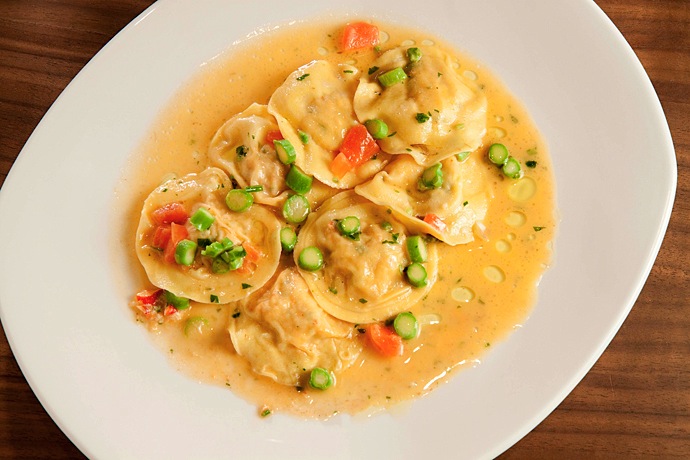 For entrees I
recommend beautifully cooked black hake wrapped
with sheets of potato and accompanied by roasted
caulflower, clams and a lobster reduction. If you're
up for meat, you can't do better than an
almond-crusted rack of lamb with Swiss chard ravioli
in a goat's cheese and sage fondue.
For entrees I
recommend beautifully cooked black hake wrapped
with sheets of potato and accompanied by roasted
caulflower, clams and a lobster reduction. If you're
up for meat, you can't do better than an
almond-crusted rack of lamb with Swiss chard ravioli
in a goat's cheese and sage fondue.
Very little on Zio's menu is to be
found on any Italian restaurant menus nearby or
elsewhere in Manhattan. The same goes for the
desserts, which include tiramisù that gets a
Kahlua sauce, Italian donuts filled with apple compote
and a vanilla sauce; and a caramelized fennel tart
with Sambuca gelato and caramel sauce, for which
you'll need something of a tolerance for anise
flavors. And if you ask Mr. Manfe for the kind of
espresso he'd make for himself, you'll get a good one.
Zio--which means "uncle"--is quite
a cool hot spot but its familial feeling of taking
good care of you and feeding you dishes you'll recall
as specific to the restaurant make this unique right
now in the Flat Iron neighborhood.
Zio is open for Brunch: 11:30 am – 4:00 pm (Weekends), Lunch: 11:30-4:00pm (Weekdays), Dinner: 4:00pm- 11:00pm (Daily); PRICE RANGE: Brunch: $11 - $23; Lunch: $12 - $36; Dinner: $18 - $40.

MAN ABOUT TOWN
by Christopher Mariani
Friday Night Cooking
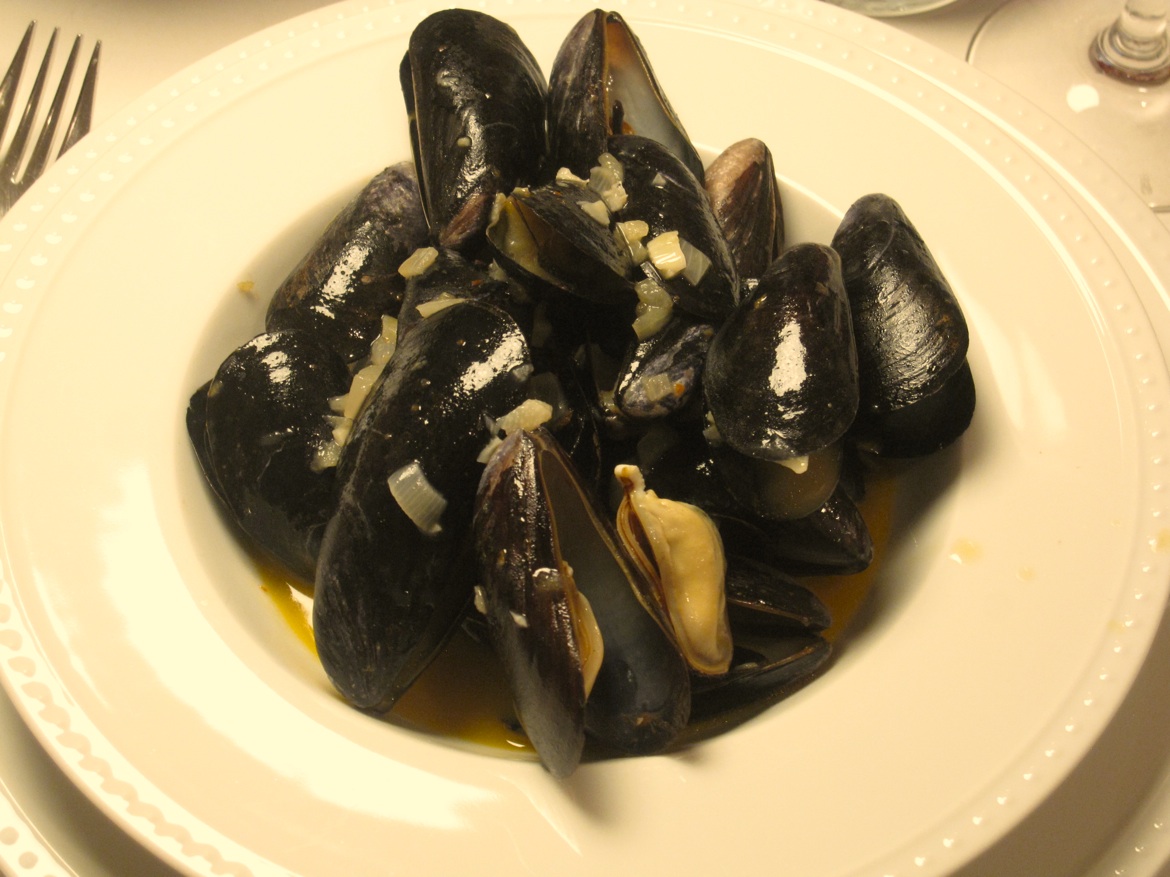 Two nights ago, I cooked a
very special, seafood-inspired dinner for my girlfriend.
It was a three-course meal, starting with mussels served
in a pool of coconut and saffron broth, followed by
linguine with white clam sauce, and finally, two steamed
3-pound lobsters sided by hot, melted, sweet butter.
Two nights ago, I cooked a
very special, seafood-inspired dinner for my girlfriend.
It was a three-course meal, starting with mussels served
in a pool of coconut and saffron broth, followed by
linguine with white clam sauce, and finally, two steamed
3-pound lobsters sided by hot, melted, sweet butter.If you live in Westchester County, there is nowhere else to go for fresh seafood than Cosenza’s on Arthur Avenue in the Bronx. Cosenza’s sits just down the street from the famous Mike’s Deli and is the only place I will go for seafood. If you like Italian food and enjoy cooking, visit Arthur Avenue for the best ingredients possible. Depending on what you are looking for, here is where to go: Mike’s Deli is the place to go for fresh mozzarella, sliced prosciutto and any and all cured meats. Biancardi’s is the last real butcher I know of in the area and offers the best cuts possible; entire lambs and carcasses hang in the display window. Biancardi’s is the last of a dying breed. Just next-door is the Madonia Brothers bakery, where you will find everything from Italian bread to pastries. The aroma of freshly baked goods permeates the entire street and is impossible to avoid. And then there is Cosenza’s. Ask for Joe or John to help you out.
I picked up two pounds of Canadian-cultivated mussels, a pound of clams and two 3-pound lobsters that Joe yanked out of the tank for me just before placing in a thick, sturdy plastic bag. After paying and saying “ciao” to Joe, I was off to the Modonia Brothers bakery for a nice loaf of Italian bread, which I would later slice, and then sauté in olive oil and butter. My final stop was to Mike’s Deli for a ball of warm mozzarella cheese just to have around the house.
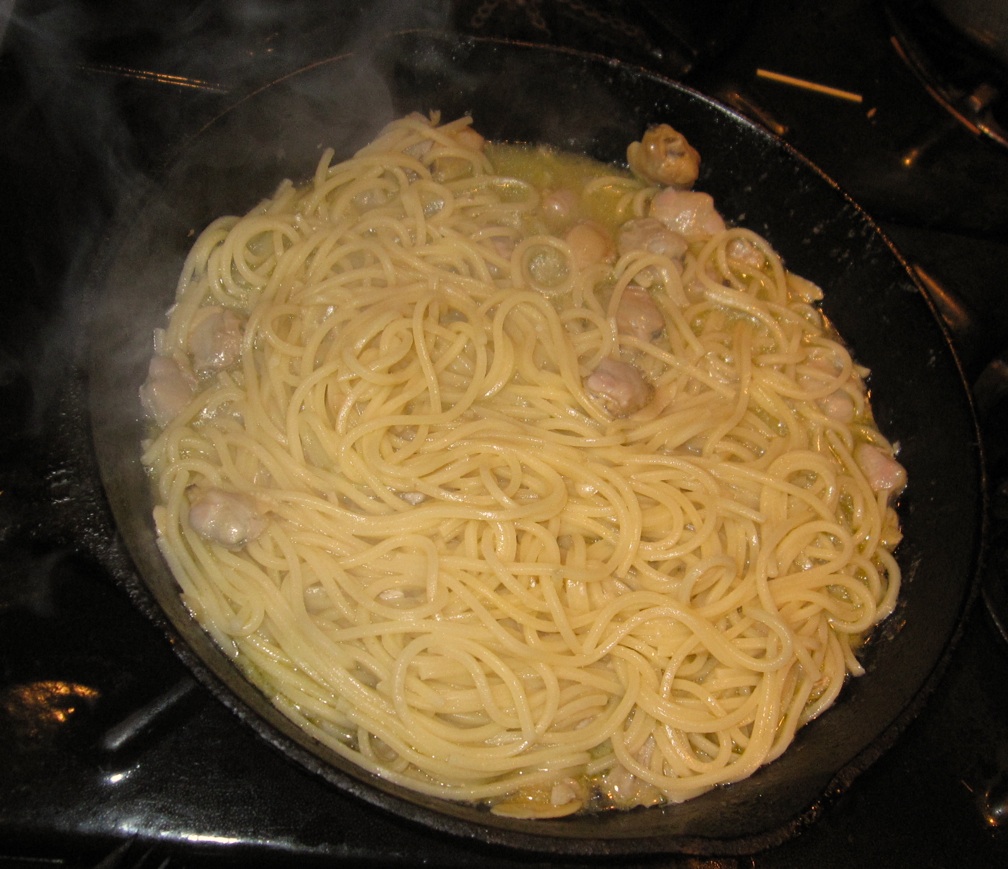 When I returned home, I
placed all the seafood in the fridge and cleaned off
the table before setting up plates, silverware, two
wine glasses and a few candles. No plastic is allowed
on this table! If you are going to serve great food,
do it right and do it with class.
When I returned home, I
placed all the seafood in the fridge and cleaned off
the table before setting up plates, silverware, two
wine glasses and a few candles. No plastic is allowed
on this table! If you are going to serve great food,
do it right and do it with class.
Then I put on my apron, made myself
a tall Negroni and started my prep work. I chopped up
tons of garlic, shallots, pre-measured the coconut
milk and placed all my pots and pans on the stove. And
so our seafood extravaganza began.
After putting on some Diana Krall,
I tossed the garlic and shallots into a pot of oil
while heating up the water for the pasta course. The
kitchen was instantly filled with the tantalizing
perfume of sizzling garlic. After sautéing the
Italian bread in olive oil and butter, I dusted the
bread with a sprinkle of sea salt and placed them in
the oven to stay warm. Next, I added a little coconut
milk and a touch of saffron to the pot, and then
tossed in the mussels and threw a lid on top, steaming
them for a few minutes. Our first course was served as
I popped a bottle of pinot noir and poured out two
glasses. Every last drop of the broth was lapped up
with the sautéed bread and things were going
well based on Katrina’s smile.
Next course was the linguine with
white clam sauce. I
started sautéing more garlic (you can never use
enough garlic when making this dish) and then added
some extra virgin olive oil and white wine. Once the
alcohol had burned off, I mixed in the clams and
cooked them for about five minutes before adding the
linguine. Some recipes recommend you chop the clams,
but when you have great clams, leave them whole. Once
served, I poured a little more wine and enjoyed the
garlicky linguine. The leftovers were eaten for lunch
just before writing this article.
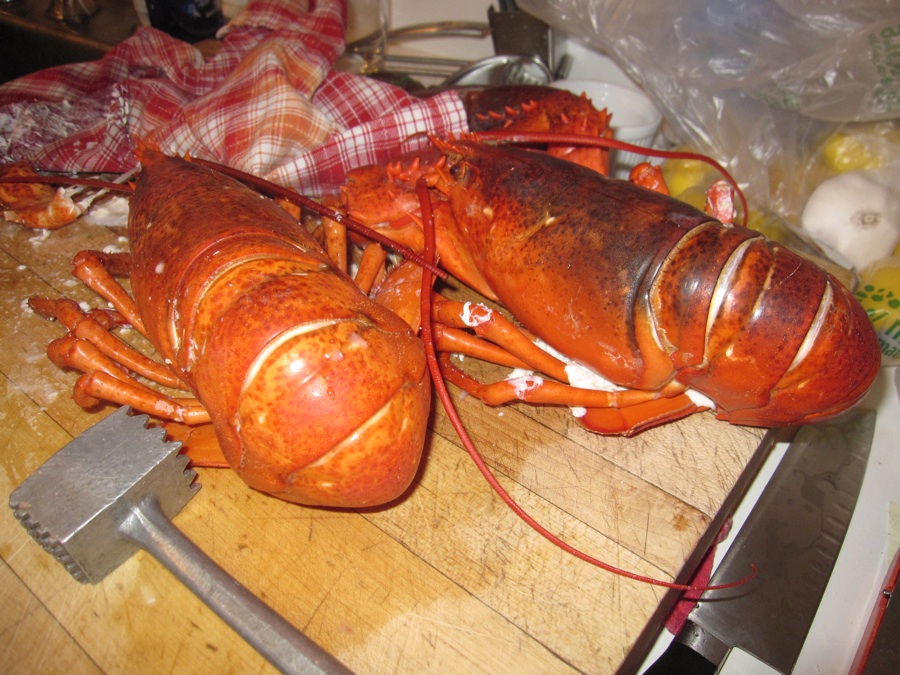 For the grand finale, I opened the fridge and pulled
out two live lobsters with their tails flapping
wildly. I placed them in the sink as the water came to
a boil. Granted, lobsters are not cheap (approximately
$13 a pound), but if you ever want to splurge, live
Maine lobsters are the way to go. Don’t waste your
time or money with those mushy frozen lobster tails
from the supermarket that generally are of the lowest
grade lobster. Once the water was boiling, I tossed in the lobsters
and steamed them for about eighteen minutes. Two to
three pound lobsters should be cooked for 15-20
minutes, never more.
Once cooked, I pulled those beautiful lobsters out and
placed them on my wooden cutting board where I cracked
open their claws and cut open their tails to pull out
the tender white meat. We ate every section of both
lobsters and dipped each bite into a yellow pool of
melted butter. Life can be very good at times.
For the grand finale, I opened the fridge and pulled
out two live lobsters with their tails flapping
wildly. I placed them in the sink as the water came to
a boil. Granted, lobsters are not cheap (approximately
$13 a pound), but if you ever want to splurge, live
Maine lobsters are the way to go. Don’t waste your
time or money with those mushy frozen lobster tails
from the supermarket that generally are of the lowest
grade lobster. Once the water was boiling, I tossed in the lobsters
and steamed them for about eighteen minutes. Two to
three pound lobsters should be cooked for 15-20
minutes, never more.
Once cooked, I pulled those beautiful lobsters out and
placed them on my wooden cutting board where I cracked
open their claws and cut open their tails to pull out
the tender white meat. We ate every section of both
lobsters and dipped each bite into a yellow pool of
melted butter. Life can be very good at times.
After a lengthy clean up and
another glass of wine, I opened the freezer and pulled
out a pint of Ben and Jerry’s Mint Chip ice cream. We
even indulged in a little chocolate syrup. It was
Friday, and we had all the reason in the world to
celebrate.
I cook often because I enjoy it.
There is absolutely no greater pleasure than cooking
and eating with the one you love over a nice bottle of
wine. The following morning I made popovers and French
style eggs, but that’s for another article.
Esoteric Grapes
Make Roussillon Wines a Puzzle
by John Mariani
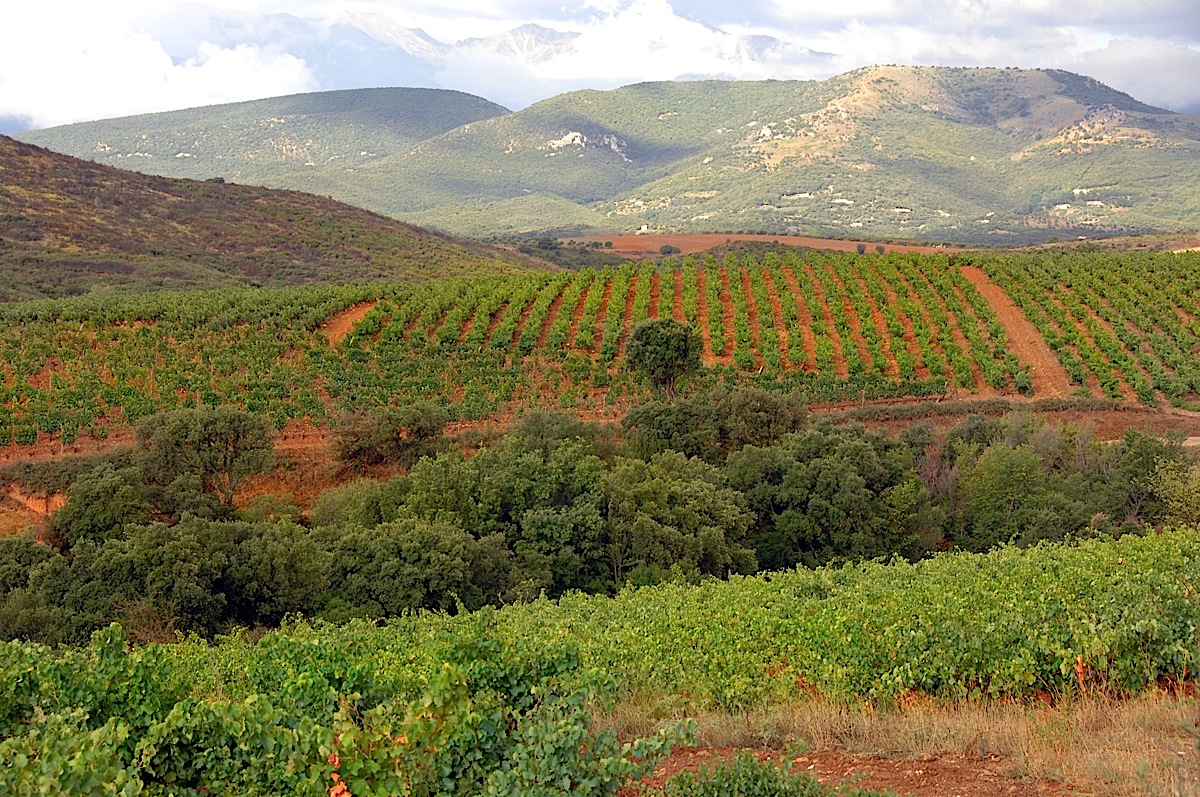
Roussillon Paysages Terrassous
Grape vines here date back to the ancient Greeks, and legend has it that in 217 B.C. deserters from Hannibal’s army stayed behind in the region to become farmers and vignerons. By the late Middle Ages Roussillon’s sweet Vin Doux Naturel liqueur was much admired. As elsewhere in the French countryside, most of the wines of Roussillon rarely rose above the level of mediocrity and were often blended with bolder, higher alcohol North African wines. Few vintners knew exactly what vines were growing in which vineyard after a millennium of cross-pollination.
Back in 1977 the then authoritative Alex Lichine’s New Encyclopedia of Wines & Spirits declared that the only Roussillon wines “of outstanding character” were sweet and fortified with brandy. Only in the 1930s were the better wines classified. In 1977 Cotes du Roussillon and Cote des Roussillon Villages were given A.O.C.s (Appellation d’Origine Contrôlée), though under EU rules, the wines are being labeled AOP (Appellation d’Origine Protegée). Today the region’s 4,500 growers, many part-timers, produce two percent of French wine by volume, with
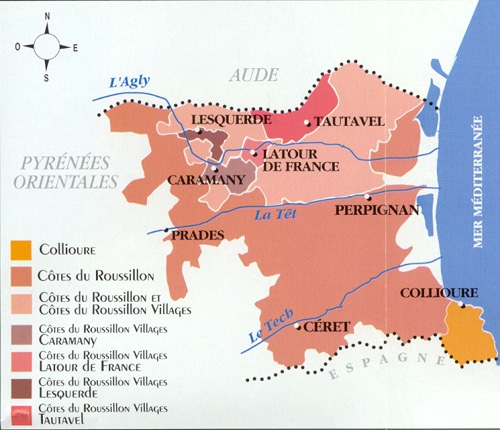 75 percent made by cooperatives.
75 percent made by cooperatives.Adding to the difficulty of pinning down Roussillon’s wines are its wide range of soils of the Pyrenees and the Mediterranean, with various regions rich in granite, limestone, iron, sand, salt, and clay. The climate is dry in summer, rainy in autumn and spring. Aside from the more esoteric varietals like macabeu, lladoner pelut, and tourbat, Roussillon produces wine from more widely propagated grapes like grenache, marsanne, muscat d’Alexandrie, cinsault, syrah, and mourvèdre. These are those most likely to be found in wine stores outside of the region. U.S. importers seeking inexpensive French wines have shown increased interest in Roussillon.
A sampling of a range of Roussillon wines showed that they are at their most attractive with food, not least summer dishes from the grill. You would not be criticized if you thought some of the reds were Spanish, for there is bright fruit and depth in the bottlings, and what they lack in complexity, they make up for in body.
A 2008 Domaine Cabirau Côtes du Roussillon Malgre les fonctionnaires (“in spite of the civil servants”) was inky in its color, and, at 14.5 percent alcohol, a very big red wine indeed, based on a blend of 70 percent grenache, 20 percent syrah, and 10 percent carignan.
Walden Côtes du Roussillon has won acclaim as one of the newcomers to the region, stressing the most modern winemaking techniques and committed to keeping its prices low. Indeed, the 2007, at $15, is a real bargain, with a solidly knit combination of rich fruit and acid, with a big 14.5 percent alcohol. It is a cliché to call any wine a “food wine,” but this one really comes alive next to a slab of beef. By the way, the name Walden was inspired by Walden Pond in Massachusetts, where nature philosopher Henry David Thoreau lived and worked.
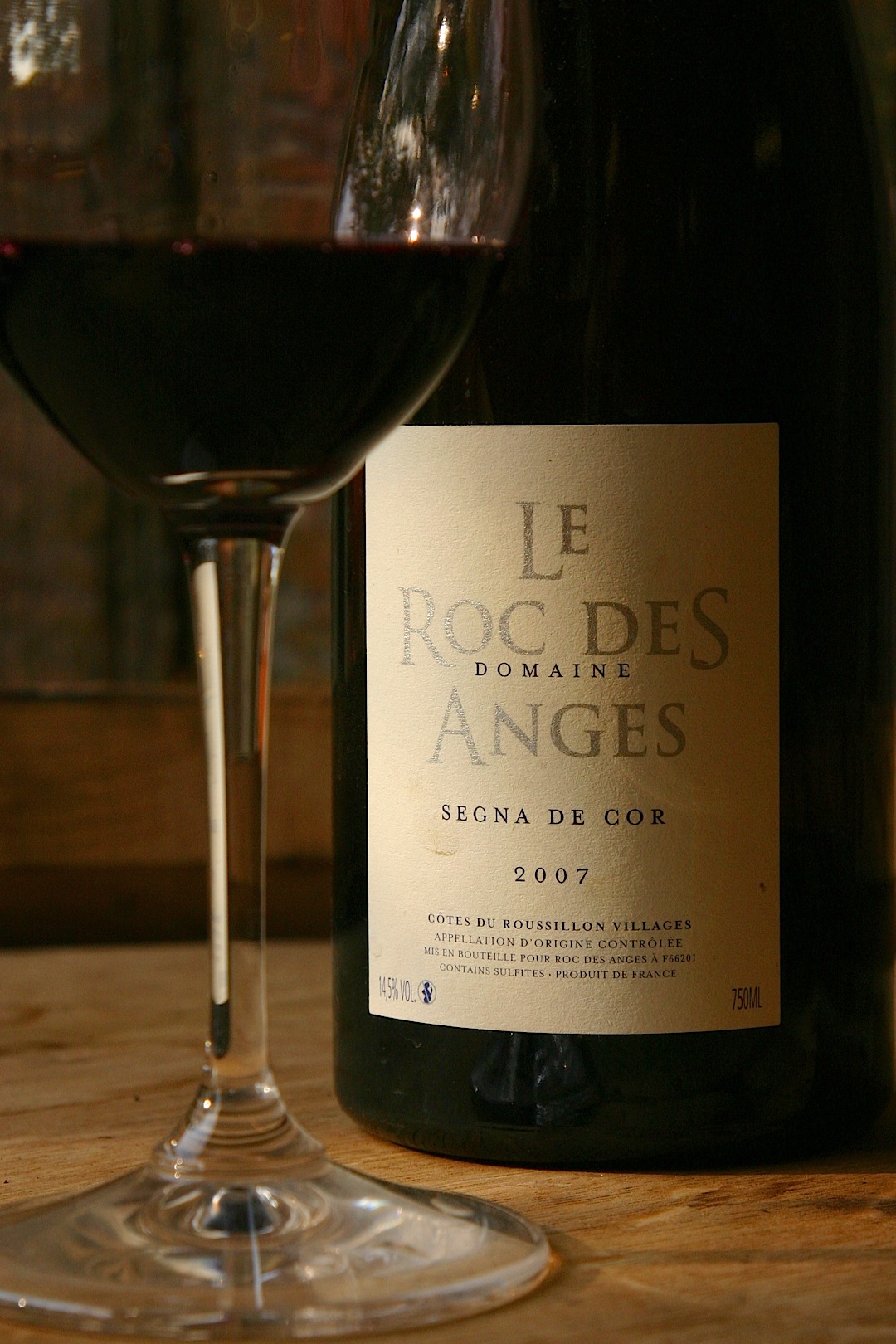 Lower in alcohol
at 13 percent, Château de Jau 2008 Côtes du
Roussillon Villages ($12) was more velvety, deep and
dark and with the full flavor of four varietals—45
percent syrah, 30 mourvedre, 15 carignan, and 10
grenache. The estate dates to the 12th
century, since 1974 owned by the Daure family, and there
is a restaurant here, Le Grill, that would make an ideal
place to drink the family’s wines. They recommend this
wine with a pot au feu or blanquette de veau.
Lower in alcohol
at 13 percent, Château de Jau 2008 Côtes du
Roussillon Villages ($12) was more velvety, deep and
dark and with the full flavor of four varietals—45
percent syrah, 30 mourvedre, 15 carignan, and 10
grenache. The estate dates to the 12th
century, since 1974 owned by the Daure family, and there
is a restaurant here, Le Grill, that would make an ideal
place to drink the family’s wines. They recommend this
wine with a pot au feu or blanquette de veau.I also enjoyed two whites in my sampling, a grenache blanc-based 2009 M. Chapoutier Bila-Haut Côtes du Roussillon ($11), which had a very perfumed, floral nose and a grassiness similar to a sauvignon blanc. Gerard Bertrand Muscat O 2010 ($11) shows why this varietal—actually two: muscat of Alexandria and muscat petit--has long been the most favored in the region. Made from low grape yields, the juice stays on the lees for a while to develop body and intensity. At 10 percent alcohol, it is an extremely easy to drink white wine as an aperitif or with shellfish.
By the way, if you’ve ever dreamed of owning a wine estate in France, Roussillon may be a good bet. According to the owners of Walden, land is “dirt cheap, one of the least expensive in the world” and has the “highest percentage of old vine stock than any wine region in France,” where “bad vintages are rare.”
❖❖❖
AND THEY SEEMED
LIKE SUCH NICE GIRLS!
After visiting NYC's Hustler Club, customer W.A. Ilg
brought suit, saying he was "wrongfully served
plaintiff excess alcoholic beverages such that
plaintiff was no longer capable of conducting
financial transactions. . . Thereafter, defendant
wrongfully charged $28,109.60 to plaintiff's credit
card" just for alcohol. This is the second time the
club was sued: Last year, a Delaware man, Gerard Wall,
said he suffered a 90-minute memory gap and
found a $21,000 charge on his credit card after having
two drinks, and was then "was approached by a
dancer, who invited him to have a private lap dance in
a separate room" for $300. The next thing he
knew we woke up in a car that hired by the club to
drive home. The Hustler Club denied any
wrongdoing in the Wall case, citing his "culpable
conduct."
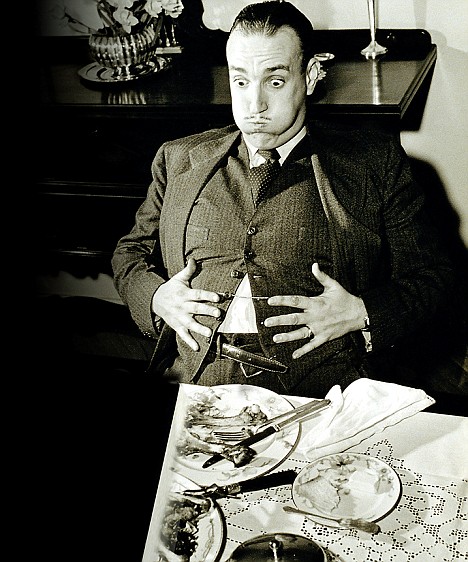 OO-LA-LAH!
OO-LA-LAH!
A NYC
inspector for the
Michelin Guides tweeted, "What an incredible
dinner
at Le Bernardin last night. The best in
years," despite the restaurant's
being closed for vacation.
Any of John Mariani's
books below may be ordered from amazon.com.
"Eating Italian will never be the same after reading John Mariani's entertaining and savory gastronomical history of the cuisine of Italy and how it won over appetites worldwide. . . . This book is such a tasteful narrative that it will literally make you hungry for Italian food and arouse your appetite for gastronomical history."--Don Oldenburg, USA Today. "Italian
restaurants--some good, some glitzy--far
outnumber their French rivals. Many of
these establishments are zestfully described
in How Italian Food Conquered the World, an
entertaining and fact-filled chronicle by
food-and-wine correspondent John F.
Mariani."--Aram Bakshian Jr., Wall Street
Journal.
"Equal parts
history, sociology, gastronomy, and just
plain fun, How Italian Food Conquered the
World tells the captivating and delicious
story of the (let's face it) everybody's
favorite cuisine with clarity, verve and
more than one surprise."--Colman Andrews,
editorial director of The Daily
Meal.com. "A fantastic and fascinating
read, covering everything from the influence
of Venice's spice trade to the impact of
Italian immigrants in America and the
evolution of alta cucina. This book will
serve as a terrific resource to anyone
interested in the real story of Italian
food."--Mary Ann Esposito, host of PBS-TV's
Ciao
Italia. "John Mariani has written the
definitive history of how Italians won their
way into our hearts, minds, and
stomachs. It's a story of pleasure over
pomp and taste over technique."--Danny Meyer,
owner of NYC restaurants Union Square Cafe,
Gotham Bar & Grill, The Modern, and
Maialino.
|
 |
 |
 |
 |
 |
 |
 |
 |
 Everett Potter's Travel Report:
Everett Potter's Travel Report: 
 Eating Las Vegas
is the new on-line site for Virtual Gourmet
contributor John A. Curtas., who since 1995
has been commenting on the Las Vegas food
scene and reviewing restaurants for Nevada
Public Radio. He is also the
restaurant critic for KLAS TV, Channel 8 in
Las Vegas, and his past reviews can be
accessed at KNPR.org.
Click on the logo below to go directly to
his site.
Eating Las Vegas
is the new on-line site for Virtual Gourmet
contributor John A. Curtas., who since 1995
has been commenting on the Las Vegas food
scene and reviewing restaurants for Nevada
Public Radio. He is also the
restaurant critic for KLAS TV, Channel 8 in
Las Vegas, and his past reviews can be
accessed at KNPR.org.
Click on the logo below to go directly to
his site.

Tennis Resorts Online: A Critical Guide to the World's Best Tennis Resorts and Tennis Camps, published by ROGER COX, who has spent more than two decades writing about tennis travel, including a 17-year stretch for Tennis magazine. He has also written for Arthur Frommer's Budget Travel, New York Magazine, Travel & Leisure, Esquire, Money, USTA Magazine, Men's Journal, and The Robb Report. He has authored two books-The World's Best Tennis Vacations (Stephen Greene Press/Viking Penguin, 1990) and The Best Places to Stay in the Rockies (Houghton Mifflin, 1992 & 1994), and the Melbourne (Australia) chapter to the Wall Street Journal Business Guide to Cities of the Pacific Rim (Fodor's Travel Guides, 1991).


The Family Travel Forum - A
community for those who "Have Kids, Still Travel" and
want to make family vacations more fun, less work and
better value. FTF's travel and parenting features,
including reviews of tropical and ski resorts, reunion
destinations, attractions, holiday weekends, family
festivals, cruises, and all kinds of vacation ideas
should be the first port of call for family vacation
planners. http://www.familytravelforum.com/index.html
ALL YOU NEED BEFORE YOU GO


MARIANI'S VIRTUAL GOURMET
NEWSLETTER is published weekly. Editor/Publisher: John
Mariani.
Contributing Writers: Christopher Mariani, Robert Mariani,
John A. Curtas, Edward Brivio, Mort Hochstein,
Suzanne Wright, and Brian Freedman. Contributing
Photographers: Galina Stepanoff-Dargery,
Bobby Pirillo. Technical Advisor: Gerry McLoughlin.
© copyright John Mariani 2011
